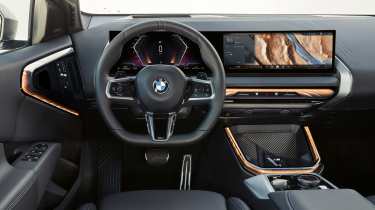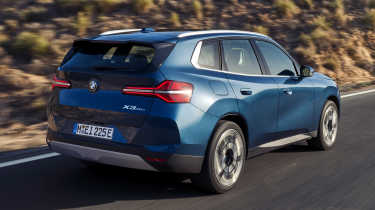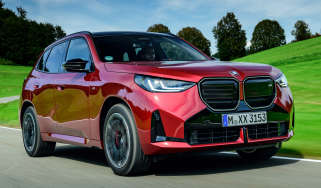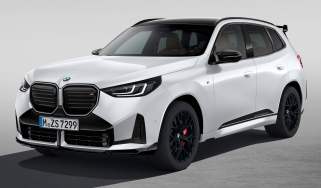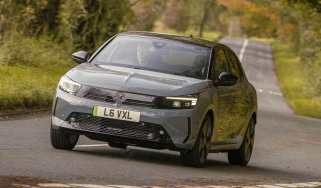No more EV! New BMW X3 gets petrol, diesel and PHEV power only
The all-new premium BMW X3 SUV has a sharp new look and cutting-edge tech, but no iX3 EV this time around
This is the all-new BMW X3. The brand’s mid-size premium SUV has proven immensely popular over its former three generations, and as such is a main profit driver for the German brand globally. Now in its fourth generation, this new model has been redesigned from the ground up to suit combustion and plug-in hybrid powertrains exclusively.
That’s right – the also big-selling all-electric iX3 won’t be offered this time around. The EV’s demise leaves space for the impending Neue Klasse SUV, however, which is due to be shown next year before going on sale shortly after.
The new X3 will initially be offered with four engine options, kicking off with a turbocharged four-cylinder petrol option with a 48-volt mild-hybrid system. Badged xDrive20, BMW is quoting a peak power figure of 205bhp, allowing it to hit 62mph in 7.8 seconds while still offering a 40.9mpg combined fuel consumption figure. Pricing will kick off at £46,800 in the UK, with first cars arriving by the end of 2024.
In contrast to the recently updated 3 Series, BMW will still offer a diesel powertrain for the X3. The xDrive20d (priced from £48,210) features a 194bhp 2.0-litre diesel unit, also aided by a mild-hybrid system. It’ll reach 62mph in 7.7 seconds, and returns up to 48.7mpg on the combined cycle. The engine is rated to Euro 6e emissions regulations; BMW will add a six-cylinder diesel to the range in 2025.
Above this sits the heavily updated xDrive30e plug-in hybrid (from £56,340), which pairs a turbocharged 2.0-litre four-cylinder petrol engine with a 22.3kWh battery pack and an electric motor. Peak combined power stands at 294bhp, but the headline figure here is the 54-mile all-electric range, and 313mpg combined fuel economy. This rating is a little disingenuous given the quirks of plug-in hybrids and how they operate during the WLTP testing procedure, but unusually, BMW has also released an MPG figure for when the batteries are depleted. This stands at 39.2mpg.
At the top of the range is the £64,990 M50 xDrive, which at the time of writing, is the only six-cylinder powertrain option until that top-spec diesel arrives next year. The M50’s twin-turbo ‘B58’ unit has been tweaked to produce 392bhp, enabling a 0-62mph sprint of 4.6 seconds. Thanks to its own MHEV system, BMW claims the M50 can return up to 36.7mpg.
The M50 also picks up a few extra chassis upgrades, such as larger M Sport brakes, an M Sport differential, and variable sports steering, as well as standard-fit 20-inch wheels. BMW is expected to reveal a new X3 M Competition in time, but this isn’t likely to arrive for another couple of years.
Those wanting an all-electric BMW SUV of this size will have to wait until the firm launches the production variant of the Neue Klasse X concept in 2025 – a model that will run on a new electric architecture. This will see lots of innovations like a full-width head-up display in the cockpit and the next generation of battery technology, keeping this new X3 optimised for combustion powertrains.
All X3 models benefit from a lighter and stiffer structure, with a wider rear axle and new double-joint strut front axle suspension and a five-link rear. All models come as standard with coil springs and passive dampers, with adaptive dampers available on the options list. There is no optional air-suspension system or rear-wheel steering as you might find in some premium rivals.
Without the need to support a pure-electric powertrain, BMW has been able to optimise the body and chassis specifically for the petrol, diesel and hybrid engines, keeping the weight sensible across the different variants. At its lightest, BMW quotes a weight figure of 1,855kg, rising to 2,065kg for the plug-in hybrid.
What most customers will notice though, is the X3’s new design, which features a combination of historic BMW styling features, alongside the more sculptural body of models like the iX SUV. There are two main trims on offer – xLine and M Sport – but in both cases the overall effect is modern and slick, if not as bold as some of BMW’s other models.
The body itself hasn’t grown much, at just 40mm longer and 20mm wider. The X3 now sits 25mm lower, enhancing the car’s sense of width. The kidney grilles are more restrained than in many of BMW’s recent models, and can be specified with glowing surrounds as an option. The LED headlights are sleeker and feature adaptive matrix high beams, and can be in a standard or ‘shadowline’ finish with blue internal elements.
The rear end takes a bigger step away from the current generation, with a more sculpted bootlid and a relocation of the number plate onto the rear bumper.
Depending on specification, BMW will offer wheel sizes of between 18 and 21-inches. M Sport models will represent a majority of UK sales, with their own bumpers, darkened trim elements and a larger rear wing.
The cabin represents a much larger departure in terms of design, materials and technology, though. The dash is dominated by a large curved screen that combines a 12.3-inch driver’s display and 14.9-inch touchscreen. The driver’s display is controlled mostly via the new steering wheel, which features the same new controls as you’ll find on other recent BMW models like the latest 3 Series and 5 Series.
Underneath the screen, BMW has also fitted the illuminated touch panel from the new 5, with a few key controls. But beyond this there is little in the way of physical buttons on the dashboard itself. The centre console features a switch-like gear selector and the iDrive controller, alongside the usual collection of controls for the drive modes, volume and parking aids.
All of this tech is housed in a more contemporary cabin, with the use of fabric and other soft-touch materials across the dash and doors, plus clever use of illumination that will vary between the different models and the chosen driver mode. All models will also feature BMW’s all-new OS 9 operating system, plus the latest generation Harman Kardon stereo.
BMW is quoting a boot capacity of 570 litres, or up to 1,700 litres with the second row of seats folded. These figures drop to 460 litres (or 1,600 litres) for the plug-in hybrid. Depending on the powertrain, the new X3 is also tow-rated to 2,500kg.
The new X3 enters a fierce part of the market, with Mercedes and Audi also offering rivals that feature petrol, diesel and plug-in hybrid options. Outside of its traditional competitor set, Volvo’s XC60 continues to prove popular with buyers, and the Range Rover Velar still offers a stylish take on the traditional SUV package. For those who want a more rakish exterior design, a new generation BMW X4 won’t be far away, offering a sloping roofline and sportier look.
Click here for all the latest on the forthcoming all-electric BMW Neue Klasse SUV...



